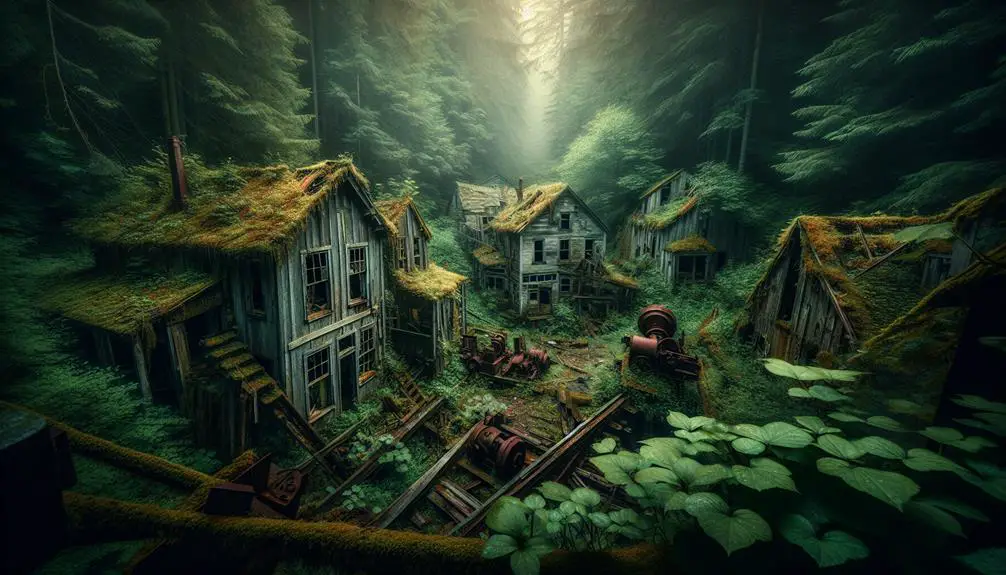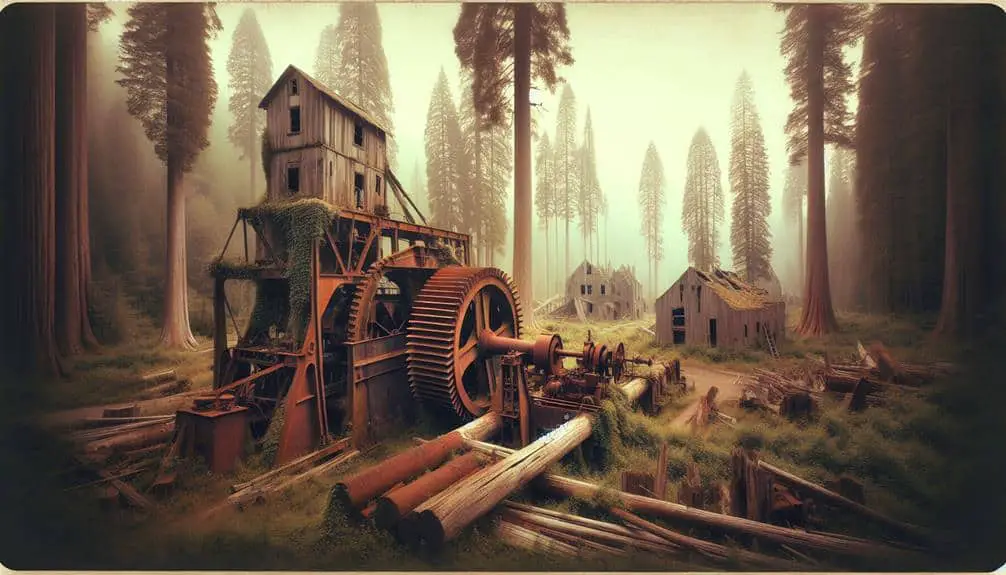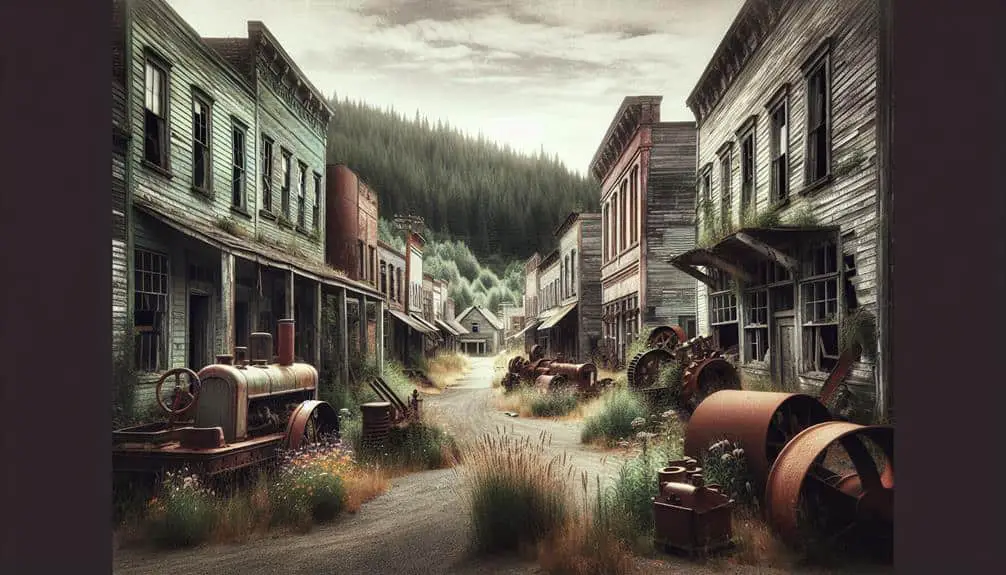Discover the hidden history of lost logging towns in the USA. Uncover forgotten communities where the remnants of a once-thriving industry now stand as eerie reminders of the past. Explore decaying cabins, rusting sawmills, and overgrown railway tracks that paint a picture of a bygone era. Understanding the causes of abandonment, from rapid deforestation to economic shifts, offers insight into these haunting ruins. Preservation efforts face challenges, but the tales of popular logging ghost towns like Bodie and Centralia continue to captivate those curious about the human and environmental costs of logging activities.
Key Points
- Abandoned logging towns reflect economic shifts and environmental impacts.
- Forgotten communities once thrived on logging activities.
- Decaying cabins and rusting sawmills are haunting remnants of the past.
- Preservation efforts face financial constraints and environmental challenges.
- Popular logging ghost towns include Bodie, Centralia, Fayette, and Lester.
Historical Background of Logging Towns
In the history of logging towns in the USA, the development of these communities was intricately tied to the growth of the logging industry in the 19th and early 20th centuries. The economic impact of logging towns was profound, providing employment opportunities for many while also spurring local businesses that catered to the needs of loggers and their families. However, this economic prosperity came at a cost, with significant environmental consequences resulting from deforestation and habitat destruction.
Beyond their economic impact, logging towns held cultural significance as hubs of community life. They were places where unique traditions and ways of life formed, shaped by the rugged terrain and demanding work of logging. Unfortunately, the success of logging towns often led to their downfall, as the depletion of nearby forests eventually forced residents to move on, resulting in community displacement and the abandonment of once-thriving settlements.
As a result, many logging towns now stand as ghostly reminders of a bygone era, echoing the complex relationship between economic development, environmental sustainability, and community heritage.
Causes of Abandonment
The decline and eventual abandonment of logging towns in the USA can be attributed to a combination of factors. Rapid deforestation, shifting market demands, and technological advancements in logging practices all played a part. Economic decline was significant as logging became less profitable due to increased competition and changing consumer preferences. Natural disasters like wildfires or floods also devastated many logging towns, making it economically unfeasible to rebuild.
As deforestation accelerated, once abundant resources began to dwindle, leading to higher operational costs for logging companies. This, along with the emergence of alternative materials and energy sources, caused a shift in market demands away from traditional logging practices. Technological advancements in logging equipment made operations more efficient but also reduced the need for manual labor, resulting in job losses within these communities.
In essence, the perfect storm of economic decline, environmental degradation, and changing market dynamics contributed to the abandonment of logging towns across the USA.
Haunting Remnants of Logging Industry
Nestled beneath the dense canopy of trees, ghostly remnants of the logging industry linger like echoes of a bygone era, silently bearing witness to a once-thriving community's legacy. These ghostly ruins stand as solemn reminders of the forgotten communities that once thrived on the bustling activities of the logging industry. Rusting sawmills, overgrown railway tracks, and decaying cabins whisper stories of the past, inviting exploration into the lives of those who toiled in the forests.
As you walk through these haunting remnants, you can almost hear the sounds of axes striking timber and the distant whistle of locomotives hauling felled trees. The abandoned structures, now reclaimed by nature, evoke a sense of nostalgia for a time when these forgotten communities flourished. Each decaying building, each rusted tool left behind, paints a vivid picture of the challenges and triumphs faced by the loggers who once called these places home.
Exploring these ghostly ruins offers a glimpse into a world long forgotten, where the logging industry shaped landscapes and lives in ways that still resonate today.
Preservation Efforts and Challenges
Amidst the efforts to preserve the haunting remnants of the logging industry, numerous challenges emerge, requiring innovative solutions and dedicated commitment to guarantee the conservation of these historical sites. Challenges faced in the restoration efforts of these lost logging towns range from financial constraints to environmental degradation. The financial aspect often poses a significant hurdle, as restoring and maintaining these sites can be costly. Finding sustainable funding sources becomes imperative to guarantee these historical places aren't lost to time.
Moreover, the natural elements and time have taken their toll on these ghost towns. Decaying structures, overgrown vegetation, and vandalism further complicate restoration efforts. Balancing the need to preserve the authenticity of these sites with the necessity of ensuring visitor safety is a delicate task. Additionally, engaging local communities and fostering a sense of stewardship towards these historical locations prove essential for long-term preservation. By addressing these challenges with strategic planning and community involvement, the restoration efforts can successfully safeguard the legacy of these lost logging towns for generations to come.
Popular Logging Ghost Towns
Exploring the historical remnants of popular logging ghost towns reveals a fascinating narrative of the once-thriving communities intertwined with the logging industry's rise and fall. Forgotten settlements like Bodie in California, a former gold-mining town turned lumber hub, stand as eerie reminders of a bustling past now reclaimed by nature. These abandoned communities, such as Centralia in Pennsylvania, where an underground mine fire led to the town's evacuation, spark curiosity about the human and environmental costs of logging activities.
In Michigan, Fayette Historic State Park preserves the essence of a 19th-century iron-smelting and logging community, offering a glimpse into the challenges faced by inhabitants during industrial expansions. Similarly, the remnants of Lester in Washington, once a crucial logging town, evoke contemplation on the transitory nature of economic booms and busts in resource-dependent regions.
As you traverse these ghost towns, ponder the lives lived and lost in pursuit of logging prosperity, and reflect on the delicate balance between progress and preservation in the evolving landscape of America's logging history.
Frequently Asked Questions
Are There Any Ghost Towns That Were Once Thriving Logging Towns but Are Now Completely Submerged Underwater Due to Dam Construction?
You might be surprised to learn that there are indeed submerged towns that were once thriving logging communities, lost due to dam construction. The environmental impact, presence of female loggers, archaeological discoveries, and rumors of paranormal activity add layers of intrigue.
How Did the Logging Industry Impact the Local Wildlife and Ecosystems in These Abandoned Towns?
When logging altered ecosystems, biodiversity suffered. Efforts now focus on restoring balance. Logging towns left scars; restoration seeks healing. Wildlife and habitats impacted, but restoration aims for harmony, a shared future.
What Role Did Women Play in These Logging Towns, and Are There Any Notable Stories of Female Loggers or Workers?
In these logging towns, women were often the unsung heroes. Female pioneers took on roles typically reserved for men, showcasing strength and resilience. Forgotten stories of female loggers highlight their crucial contributions to the industry and community.
Have There Been Any Recent Archaeological Discoveries in These Logging Ghost Towns That Shed New Light on Their History?
Have there been new excavations revealing archaeological findings in logging ghost towns? These discoveries shed light on historical mysteries, uncover forgotten artifacts, and contribute to cultural preservation by exploring industrial ruins and untold stories.
Are There Any Documented Cases of Paranormal Activity or Hauntings in These Abandoned Logging Towns?
You won't believe the spine-tingling tales that circulate about paranormal activity in abandoned logging towns. Paranormal investigations and local legends intertwine to reveal a haunted history filled with supernatural encounters that defy explanation.



